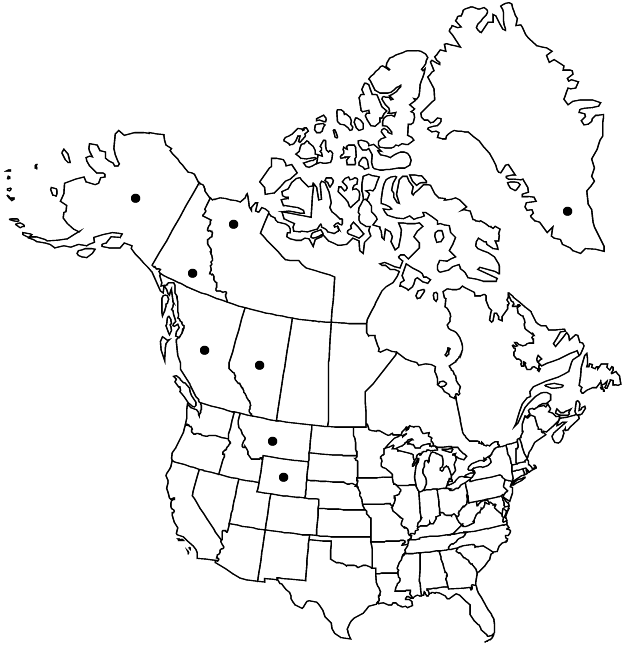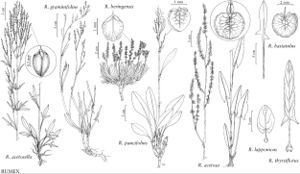Difference between revisions of "Rumex lapponicus"
in B. N. Gorodkov and A. I. Pojarkova, Fl. Murmansk. Obl. 3: 154. 1956.
FNA>Volume Importer |
FNA>Volume Importer |
||
| Line 8: | Line 8: | ||
}} | }} | ||
|common_names=Lapland or Lapland mountain sorrel | |common_names=Lapland or Lapland mountain sorrel | ||
| − | |basionyms={{Treatment/ID/ | + | |basionyms={{Treatment/ID/Basionym |
|name=Rumex acetosa subsp. lapponicus | |name=Rumex acetosa subsp. lapponicus | ||
|authority=Hiitonen | |authority=Hiitonen | ||
| + | |publication_title=Suom. Kasvio, | ||
| + | |publication_place=300. 1933 | ||
}} | }} | ||
|synonyms={{Treatment/ID/Synonym | |synonyms={{Treatment/ID/Synonym | ||
| Line 62: | Line 64: | ||
|publication year=1956 | |publication year=1956 | ||
|special status= | |special status= | ||
| − | |source xml=https://jpend@bitbucket.org/aafc-mbb/fna-data-curation.git/src/ | + | |source xml=https://jpend@bitbucket.org/aafc-mbb/fna-data-curation.git/src/f6b125a955440c0872999024f038d74684f65921/coarse_grained_fna_xml/V5/V5_1030.xml |
|subfamily=Polygonaceae subfam. Polygonoideae | |subfamily=Polygonaceae subfam. Polygonoideae | ||
|genus=Rumex | |genus=Rumex | ||
Revision as of 20:06, 24 September 2019
Plants perennial, glabrous or nearly so, with short and relatively thin, horizontal or slightly oblique rootstock (usually not reaching deep into substrate) and ± crowded 2d-order roots (occasionally with short-creeping rhizome). Stems erect, rarely ascending, several from base or often solitary, branched in distal 1/2 (in inflorescence), (10–)20–60(–100) cm. Leaves: ocrea of at least middle and distal leaves with margins entire, not fringed, sometimes laciniate but only in distal parts; blade broadly ovate, rarely almost round, oblong-ovate, rarely oblong-lanceolate, 3–10(–14) × 1–4(–5) cm, normally less than 2.5 times as long as wide, base sagittate (with acute or subacute lobes directed downward, ± parallel to petiole, or slightly incurved inward), margins entire, normally flat, apex subacute or obtuse. Inflorescences terminal, occupying distal 1/3 of stem, usually lax and interrupted especially in proximal part, narrowly paniculate or occasionally simple, cylindric (with 1st-order branches simple, or with few 2d-order branches). Pedicels articulated near middle, filiform, 2–5 mm, articulation distinct. Flowers (2–)4–8 in whorls; inner tepals orbiculate, occasionally broadly ovate, 3.5–4.5 × 3.5–4.5 mm, base rounded or cordate, apex obtuse; tubercles small or occasionally absent. Achenes brown or dark brown to brownish yellow, 1.7–2.5 × 0.9–1.3 mm, dull. 2n = 14 (pistillate plants), 15 (staminate plants).
Phenology: Flowering late spring–summer.
Habitat: Meadows, rock outcrops, alluvial habitats along rivers and streams in tundra and montane and subalpine zones
Elevation: 0-2500 m
Distribution

Greenland, Alta., B.C., N.W.T., Yukon, Alaska, Mont., Wyo., n Eurasia.
Discussion
The name Rumex acetosa has been commonly misapplied to R. lapponicus. Native North American montane plants of the R. acetosa aggregate from the Rocky Mountains southward to Beartooth Plateau in Montana and Wyoming usually were referred to as R. alpestris [= Acetosa pratensis Miller subsp. alpestris (Jacquin) Á. Löve; A. pratensis subsp. arifolia (A. Blytt & O. C. Dahl) Á. Löve; R. arifolius Allioni, not Linnaeus f.; R. acetosa subsp. alpestris (Jacquin) Á. Löve; R. acetosa subsp. arifolius A. Blytt & O. C. Dahl]. Recent nomenclatural studies demonstrated that R. alpestris is an ambiguous name, which was probably based on plants belonging to R. scutatus Linnaeus (see I. O. Pestova 1998), and accepted the name R. arifolius for the predominantly European montane taxon. It differs from arctic plants, as well as from montane forms of the R. acetosa aggregate from southern Siberia and temperate North America, by its more robust habit, more branched inflorescence (similar to that of R. thyrsiflorus), and larger and more acute triangular-sagittate leaves (see A. I. Tolmachew 1966; N. N. Tzvelev 1989b; Pestova; R. Elven et al. 2000). Montane races possibly developed independently from R. lapponicus-like or R. acetosa-like ancestors, and they are still unclear taxonomically. Because of that, I prefer to keep those forms within R. lapponicus. The whole aggregate needs careful study; however, some authors prefer to include all arcto-montane Holarctic races of this aggregate in the collective and rather polymorphic R. alpestris in the broad sense (see Á. Löve 1944; Löve and D. Löve 1957).
Some arctic plants from western Alaska may be conspecific with Rumex pseudoxyria (Tolmatchew) Khokhrjakov [= R. acetosa subsp. pseudoxyria Tolmatchew; Acetosa pseudoxyria (Tolmatchew) Tzvelev], a taxon described from arctic eastern Siberia (A. I. Tolmachew 1966). This entity is evidently closely related to R. lapponicus but differs from all other members of the R. acetosa group in having basal leaves less than two times as long as wide, almost hastate or at least rounded-truncate at base, resembling those of Oxyria digyna (Linnaeus) Hill, cauline leaves small or completely reduced, and inflorescence occupying more than one-half of the stem; the plant itself is also somewhat similar in appearance to the European alpine species R. nivalis Hegetschweiler.
According to E. Hultén (1973), his Rumex arcticus var. perlatus, described from a single specimen collected at Tin City, Seward Peninsula, Alaska, agrees perfectly with the original description of R. acetosa subsp. pseudoxyria. It is unlikely that Hultén would confuse two rather distantly related groups. There is also a possibility that var. perlatus is identical with R. arcticus var. latifolius Tolmatchew (see discussion under R. arcticus). Additional collections are needed to confirm the occurrence of R. pseudoxyria in northwestern North America.
Selected References
None.
